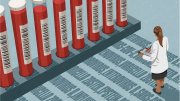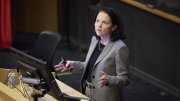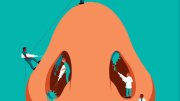Only immunity can bring an end to the current pandemic—whether through vaccination or the potentially deadly ordeal of infection. Unfortunately, it’s not a given that either a bout of COVID-19, or any of the experimental vaccines now in development, will confer long-lasting immunity. The human immune system’s response, even to a pathogen it recognizes, can range from toothless to deadly overreaction—and this coronavirus may be able to manipulate that response. To understand how people generate antibodies against SARS-CoV-2 (which causes COVID-19), and how vaccines can avoid playing into the virus’s hands, researchers in the lab of Stephen Elledge, Mendel professor of genetics and of medicine, are honing a tool developed to inventory antibodies into a method for taking a snapshot of the body’s response to COVID-19.
Two kinds of testing inform humanity’s response to this pandemic. Diagnostic tests—like the now-familiar nasal swabs—check for active infections by looking for the virus itself. Immunity tests check for past infections by searching blood serum for antibodies that bind to SARS-C0V-2: the molecular signs that our immune system has seen this specific virus before. But all antibodies are not created equal: whether the antibody actually provides immunity depends on which part of the virus’s surface it binds to.
“Some antibodies might neutralize the virus, if they bind in the right place,” says Elledge. Perhaps they prevent the virus from finding its cellular targets, or block it from entering the cell once it does. But other antibodies could hinder the neutralizing ones, without hampering the virus itself. Worse, such “bad antibodies,” as Elledge calls them, could encourage immune cells to engulf a still-dangerous virus—inadvertently helping the virus enter and infect the engulfing cell. If a vaccine induces the immune system to develop bad antibodies, that would make the infection worse.
The device Elledge’s lab has developed, called VirScan, is a serological (serum-testing) tool, like other common immunity tests, but beyond scanning for antibodies to a particular disease, it characterizes what kind of antibodies to that disease are present. Each antibody binds to a different “epitope”—a knob, bump, or handle on the surface of a virus. VirScan allows a single blood sample to flow over dozens or hundreds of different epitopes, from one virus or many, and detects whether the blood contains antibodies that bind to each epitope. Further study can then determine which epitope binding sites are most effective at neutralizing the virus.
Elledge’s group developed the relevant technology in the early 2010s, looking first for the antibodies driving autoimmune disorders like lupus and rheumatoid arthritis, and then for antibodies targeting pathogens. In 2015, the lab published what amounted to an international survey of viral exposure: with blood samples from hundreds of people on four continents, VirScan tallied not only a history of exposure—revealing which viruses the participants had encountered—but also how their antibodies bound to those viruses.
The latter data showed a surprising result: all over the world, many people exposed to a given virus generated antibodies not only to the same protein on that virus’s surface, but to the same epitope on that protein—connecting to the protein in the same way, down to the individual atoms. Given the many different epitopes on any virus, and the diversity of antibodies each person generates to a given virus, there was no a priori reason that different individuals’ immune responses should be so similar.
The team guessed this similarity was a helpful adaptation—for either humans or viruses. Because their quick reproduction means virus strains adapt much more rapidly than human populations, Elledge suspects these common epitopes are viral adaptations, serving as “red herrings” that push the human immune system into overdrive against a useless target, thwarting the body’s defenses. Subsequent research has added evidence supporting this hypothesis: in many cases, explains Tomasz Kula, Ph.D. ’19, who worked on the original study, antibodies attached to these epitopes “are not neutralizing, they don’t appear to be helpful, and yet they’re playing a really big part in the immune response.”
Elledge’s lab began using VirScan to test epitopes in SARS-CoV-2 in May, and initial results show some common epitopes. Investigating these, he says, could help vaccine researchers stay on track by enabling them to exclude candidates that stimulate bad antibodies. And identifying which antibodies actually help grant immunity, and which are diversions, could in turn help guide more accurate immunological testing as well.
Even as the accuracy of these tests improves, VirScan and related serological tests may not be enough to show that individuals are safe from the virus. Immunity is likely to wane with time, and any single test result indicating a prior immune response could be a false positive. Nevertheless, says Kula, “the chance that we can find something that can make even a small contribution” toward hastening development of an effective vaccine “is energizing. This is why we became scientists.”









